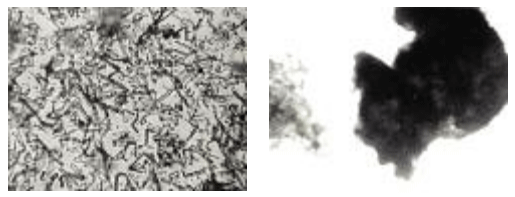The impact of crude fibre concentrate on footpad dermatitis in broilers





Dear Maheswar Rath,
Yes, ARBOCEL is a comercial product and you can buy it in India and in almost all countries in the world.
The crude fiber Content of ARBOCEL is 70 % (in the dry substance) and this is 100 % insoluble fiber. Or we have the NDF values - 97 % of ARBOCEL is NDF.
Yor are 100% right - the foot pad dermatitis is a litter moisture Status linked issue - significantly correlated.
The depth of the litter, ventilation, in some places also heating etc. can help to control the litter humidity, but if you manage trough the feeding to reduce it you do not have to ventilate, use so much bedding etc.
You are also right that the water consumption affects the litter humidity.
BUT if you reduce the soluble fiber content of the feed you will reduce also the water consumption (see the comments in my last posting).
It is well known that fibers binds watter -The famous water binding capacity WBC. But soluble fiber binds water and increase the viscosity. In this process soluble fiber with water turns to a gelatinous, viscous substance which has a cage effect. This gelatinous substance closes the nutrients and the enzymes cant reach them - in consequence the nutrients are not digested. In adition the water stays binded and goes out with the feaces.
On the opposite, in ARBOCEL binded water is free and in the last part of Intestine the water (and vitamins, minerals, nutrients etc) is reabsorbed. In consequence, the water consumtion is not higher, the feaces are dryer and the litter moisture is lower.
It´s also well known that the insoluble fiber holds longer the feed in the gizzard. If the feed is staying longer in gizzard the pH is sinking, which helps the protein digestion. This acid environment "cleans" the feed from bacterias etc. and the feed continues his way to intestine cleaner. ARBOCEL particules are so small that they fit between the intestinal willies and estimulate the growht (we did mesured this). This two factors helps to develop a healthier intestine which makes the intestine more resistant and so less diarrhea and less humidity in the litter, less medication is needed etc.
I would also like to add that the higher viscosity (means soluble fiber) holds longer the digesta in last part of intestine where the bacterias have more time to colonize etc. which means less healthy intestine, more diarrhea, less digestibility - just problems
Best Regards
If you like, you can read more about the fiber in poultry Nutrition, here
do dubt that with some other products you can reach some similar result like with fiber.
But let me try to give you some short coments:
Animals as we, do have fiber requirements. In some countries (for Pigs in Germany and Holand) there are by law regulated the Minimum fiber Content in the feed. There is a tendency that this will be a case soon also in poultry.
There are some "old" (with all due respect) meaning that the fibre in feed is not needed, or there is enough etc. But today is well known that this is not correct. There is not just need for the fibre but also there is a big difference between different fibre sources and also there are different fibers. SOLUBLE and INSOLUBLE
Fibers are two completely different ingredients
Advantages and disadvantages of soluble fibre:
Lowering intestinal passage rate
Reduces digestion of fat, protein and starch
„Prebiotic“ effect
Energy source for monogastric animals
Affects viscosity of the digesta
Mainly fermentable parts
Reduces dry matter of faeces
Binds nutrients (pectin)
Advantages and disadvantages of insoluble fibre:
Structurising“ fibre
Improves starch digestibility
Increased intestinal passage rate
Poorly fermentable
Stimulation of intestinal villi
No energy source for young monogastrics
Increases dry matter content of faeces
Prevents cannibalism
There are many, many publication about fiber in animal nutrition but I would like to comment one, which is showing clearly the difference between the soluble and insoluble fibers:
At the Aarhus University in Denmark, Sana Steenfeldt and her colleagues in 2010, compared the effect of three different feed formulations on selected health related parameters in broiler breeders. A low fibre control formulation (Total Dietary Fibre 3.03 %) and two high fibre formulations (TDF 4.19 and 3.75 %). The 2 high fibre formulations differed mainly in the ratio of soluble/insoluble fibre. One was high in insoluble fibre (insoluble NSP 90% of total NSP) and the other contained more soluble fibre (insoluble NSP 79% of total dietary fibre). The formulation containing high fibre with an elevated proportion in soluble fibres caused significant problems with wet litter.
The Litter dry matter (%) was 41a by Control group (low fibre), 70b by High fibre group (insoluble) and 25c High fibre group (elevated level soluble). Hereby a,b and c: means differ significant (p<0,001).
This trial clearly demonstrates that the nature of the fibre has significant impact on the litter quality as the proportion of soluble and insoluble fibre showed more impact on the litter humidity than the fibre level per se. Consequently there should be as much insoluble fibre in the formulation as possible. An increase of 10% soluble fibre resulted in an increase of 45% moisture in the litter. The final moisture content of 75% is by far too high. This will cause serious health problems in the birds.
Additionally the authors observed that a high level of soluble fibre causes some behavioural disorders. Already 4 hours after feeding 30 % of the birds with the elevated levels of soluble fibre showed retarded necks. A sign of discomfort. There was almost no retarded neck problem (<10%) in the birds fed a low level of soluble fibre.
Beside of the effect on litter Quality, ARBOCEL (insoluble fiber concentrate, contents 70 % crude fiber), the Protein digestibility is improved (about 5 %, not just in poultry, but pigs and other species), there is norisk of mycotoxin, by Broiler breeders less feather peacking, less dirty eggs, more hatching eggs, Higher hatchabiltiy, In Broiler breeders low densitiy feed formulations deliver some beneficial effects for healt and Performance. To achive these los density formulation a Dilution with fiber is required. The applied fibre should mainly be insoluble because as above showed, the soluble fiber may cause massive Problems with wet litter.
if you have some more questions or you Need more Information please contact me Zoltan.Gregus@jrs.de
Best Regards
We have been running studies now for the past year which include monitoring litter condition, the previous comments are all good, in particular "good enzyme". What is interesting is that if the bird itself has a good digestive process less of the bi-products that produce poor litter will be present. Key is excessive water consumption by the bird. Our results are now confirming what we have thought for one time, in that our birds generally consume more water than actually required to digest and process food while maintaining a healthy level of hydration. On average we are seeing a reduction in water intake (naturally not forced) produces a much improved gut function and subsequently a dry friable litter. As a result that is quantifiable, we are seeing up to 75% reduction on carcass rejection at processing. The research is ongoing and will continue for the next three years under Scientific conditions on a full commercial farm testing across 8 buildings. Using a lower intake as the norm, water intake is also now considered as a good indicator of stress in flocks. There are many other advantages that we are seeing and due to contractual constraints I am not yet able to tell you more. But it has been repeated successfully after a total of 32 flocks.


Bacillus Amyloliquefaciens CECT 5940 Allowed Maintaining of Performance and Accelerated Microbiota Maturation of Broilers Fed Alternative Ingredients



.jpg&w=3840&q=75)











